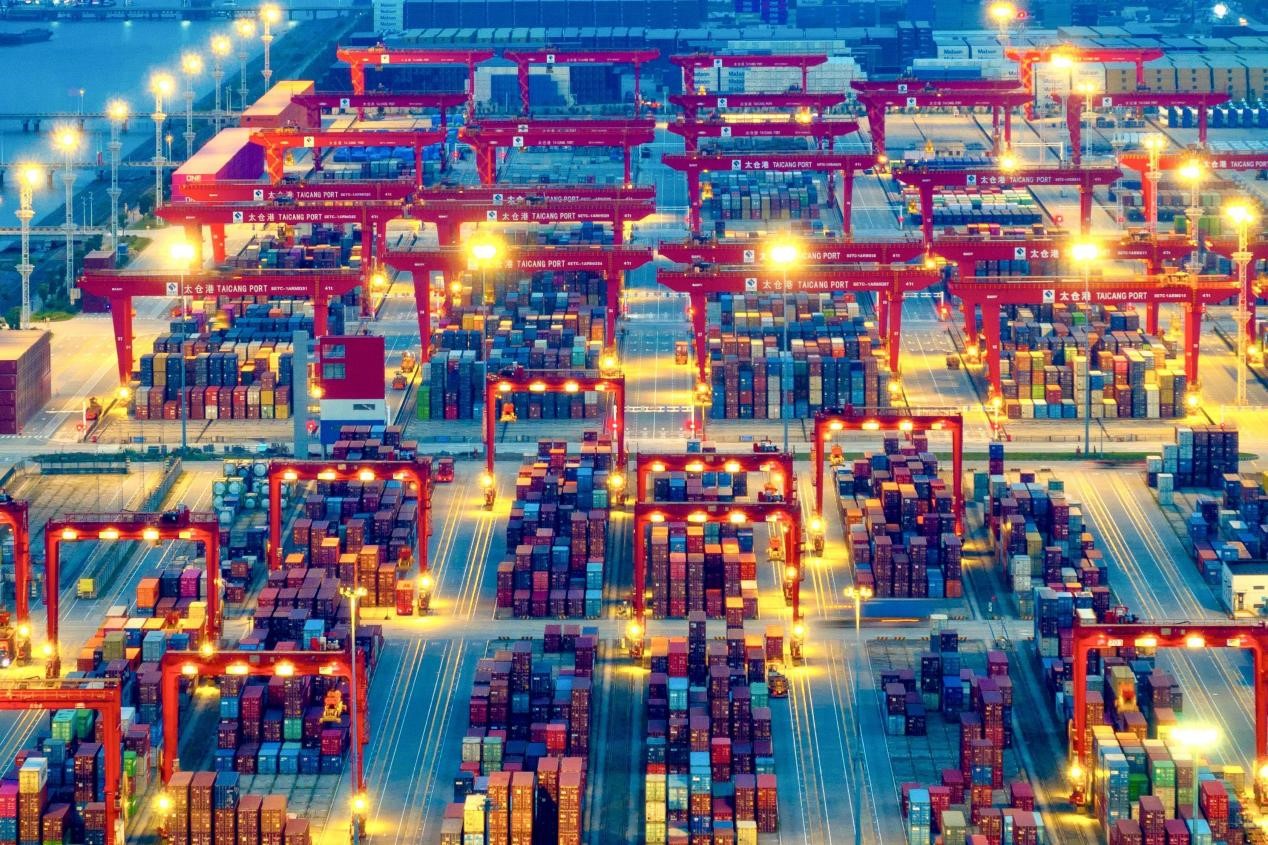Photo shows a brightly lit and bustling container terminal of Taicang Port, east China’s Jiangsu province, July 9. (People’s Daily Online/Yuan Xinyu)
China’s national economy was generally stable with steady progress in the first half of 2024, according to data released by China’s National Bureau of Statistics (NBS) on July 15.
According to preliminary estimates, the country’s gross domestic product (GDP) in the first half of 2024 reached around 61.68 trillion yuan (about $8.5 trillion), up by 5 percent year on year at constant price.
Since the beginning of this year, the momentum of world economic growth is sluggish, and effective domestic demand in the Chinese market remains insufficient, leading to increasing difficulties and challenges in current economic operations.
Against the global backdrop, the Chinese economy still delivered a sound performance.
In the first quarter of this year, China’s GDP growth rate outpaced that of the United States, the Eurozone, and Japan. Considering the situations home and abroad in the second quarter, it is expected that China’s economic growth rate will maintain its leading position in the first half of the year, and the country will remain an important engine and stabilizer for the world economy.
Despite facing both overall and structural pressures, China’s economic growth, especially in the labour-intensive service sector, has continued to recover, with the employment situation remaining generally stable during the first half of this year.
The country has witnessed improvement in the relationship between market supply and demand, while the price level maintained moderate growth during the period.
Besides, the country’s foreign trade in goods reached a new high in the first half of this year, with the goods trade volume reaching 21.2 trillion yuan and export products holding solid competitive advantages.
In the meantime, steady progress has been made in industrial transformation and upgrading, showing a growing trend towards innovation-driven and green development.
In the first half of this year, the proportion of the value-added industrial output of China’s high-tech manufacturing companies above the designated size, namely industrial firms with an annual main business revenue of at least 20 million yuan, in the total value-added industrial output of the country’s industrial enterprises above the designated size rose to 15.8 percent, up 0.6 percentage points from that of the first quarter.

Tourists have fun in Jiangbulake scenic spot in Qitai county, Changji Hui autonomous prefecture, northwest China’s Xinjiang Uygur autonomous region, July 14. (People’s Daily Online/Tao Weiming)
The country’s manufacturers of intelligent and green new products, such as integrated circuits, service robots, new energy vehicles (NEVs), and solar cells performed impressively during the first six months of this year, maintaining double-digit growth in production.
New technologies like big data and artificial intelligence have created new consumption scenarios, while new consumption models such as livestreaming e-commerce and instant delivery continued to emerge, driving an 8.8-percent year-on-year increase in online retail sales of physical goods during the first half of this year.
Meanwhile, the combined power output of hydropower, nuclear power, wind power, and solar power companies above the designated size increased by 13.4 percent year on year, accounting for a higher share in the total power output of the country’s industrial enterprises above the designated size. Besides, the energy consumption per unit of GDP in China continued to decline.
While maintaining stable economic growth, authorities from different regions in China have made continuous efforts to create a new pattern of development, adjust industrial structures, and improve development quality and efficiency in the first half of this year, striving to stimulate the internal impetus and innovation vitality of businesses, an NBS spokesperson said at a press conference.
These efforts have provided steady and sound momentum for the country’s high-quality development, the spokesperson said.
The leading role of scientific and technological innovation has been strengthened, nurturing new quality productive forces for China.
In the first half of this year, the value-added industrial output of China’s high-tech manufacturing companies above the designated size increased by 8.7 percent year on year, while the modern service industry, with typical fields including information transmission, software, and information technology services, maintained double-digit growth in value-added industrial output.
During the period, China’s production volume of intelligent products such as 3D printing equipment, service robots, and smart watches increased by 51.6 percent, 22.8 percent, and 10.9 percent year on year respectively.
Besides, the country saw a 10.6-percent year-on-year growth rate in investment in its high-tech industries during the first six months of this year, 6.7 percentage points higher than that of its overall investment.
Green and low-carbon transformation in China has been deepened, with continuous improvement in energy production and consumption structures.

Photo taken on July 15 shows wind turbines spinning in the wind in Rongcheng city, east China’s Shandong province. (People’s Daily Online/Yang Zhili)
In the first half of this year, China’s NEV output increased by 34.3 percent year on year, while its production of supporting products such as charging piles and automotive lithium-ion batteries grew by 25.4 percent and 16.5 percent respectively.
Meanwhile, China has been accelerating the construction of a clean energy system. Preliminary estimates show that the country’s proportion of non-fossil energy in total energy consumption increased by 1.9 percentage points year on year in the first half of this year.
China’s high-level opening up has continued to deepen during the first six months of 2024.
In the face of weak global economic growth momentum and increasing external uncertainties and instabilities, China has made solid strides in improving the quality and stabilizing the quantity of its exports, while steadily expanding the scale of imports. The improvement in both quality and quantity of foreign trade has made positive contributions to China’s economic growth.
In the first half of this year, the export value of products such as automobiles, ships, and integrated circuits in China increased by 22.2 percent, 91.1 percent, and 25.6 percent year on year respectively, with net exports of goods and services contributing 13.9 percent to the country’s overall economic growth.
China has been actively expanding its “circle of friends” for global economic and trade cooperation. For instance, its foreign trade value with Belt and Road partner countries increased by 7.2 percent year on year in the first half of this year.
At the same time, the country has continued to expand its visa-free policy to include more countries and promote people-to-people exchanges with other countries, leading to a significant surge in the number of foreigners visiting China for business, tourism, and reunion with relatives and friends.
In the first half of this year, China recorded over 14 million inbound trips made by foreigners, among which 8.54 million entered the country visa-free, accounting for 52 percent of the inbound trips and representing a year-on-year surge of 190.1 percent.
Despite rising challenges from home and abroad, the Chinese economy has maintained a generally stable trend, the NBS spokesperson pointed out.
China’s economic growth is not only quantitative but also qualitative. The country has delivered a commendable and substantial economic performance, said the spokesperson.
From a medium- to long-term perspective, the economic fundamentals that sustain long-term growth remain unchanged, and the trend toward high-quality development has not changed in China, according to the NBS.




















